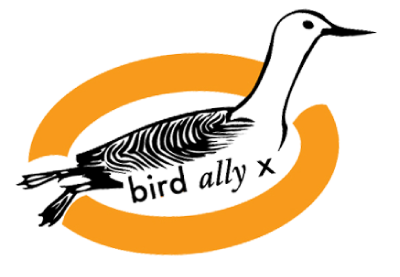In early July, on the beach at Big Lagoon park, a young Common Murre (Uria aalge) was found struggling in the surf. Too small to be in the ocean, certainly too young to be alone, without rescue certain death awaited the young bird.
Common Murres, like most alcids, spend their entire lives on the sea, coming to land only in Spring for the annual rites of renewal. Found all around the Northern Hemisphere (circumpolar), Murres nest in large colonies on rocks, seastacks and remote cliffs that are safe from predators. Before they can fly, when their wings are still quite undeveloped, parents, typically their fathers, lead the chicks from the colony out to sea and good foraging areas.
The ocean is a big place, though, and for any number of reasons, a chick can become separated from her or his parent. Without a father, the only hope these young birds have is to wash up on a beach and be found.

After a week in care, still sporting the nestling fuzz
Weighing in at 159 grams on his/her first day in care, a heatlamp and food were offered, as well as a quiet place to become accustomed to this sudden turn of events. For the time being, there would be no parent, no rolling swell of the North Pacific, no live fish freshly delivered. For the first two weeks in care, we had to put whole fish in the young seabird’s mouth to ensure s/he was eating.
While the Ancient Mariner’s complaint of “Water, water everywhere, nor any drop to drink” may be true for humans, seabirds do drink salt water. A special gland – the salt gland – filters out the excess salinity. Exposure to salt is important for this gland’s development. For this reason, among others, we provide a salted pool for young, growing seabirds.
Provided that a juvenile Murre is healthy enough to be housed in the pool without losing waterproofing or body temperature, then treatment is a relatively simple matter of periodic examinations and a lot of fish. This young bird, who at adulthood will weigh a little under two pounds (about 900 grams) ate two-thirds of a pound of fish each day, or about 40 pounds over the course of her/his care.

In the big pool for the first time

A growing baby after 8 weeks in care
From less than 200 grams to release, our youngster had to gain nearly 800 grams! Common Murres are wing-propelled “pursuit divers.” This means that they chase down fish underwater, using their wings to move – essentially flying beneath the surface of the sea! When s/he began diving in the pool we offered live fish, so that s/he could begin learning to hunt.
At last, on September 8, the young bird was as ready as s/he’d ever be for release.

Netting the Common Murre from the pool for release evaluation.

Rehabilitator Lucinda Adamson evaluates our patient for release.
Humboldt Bay opens into the North Pacific through a channel kept open by constant dredging. Not only does this allow a wide range of vessels to the bay, the channel, known locally as the Jaws, is used by seabirds of many species. At this time of year it is very common to see Common Murre fathers and their young foraging here. We chose this place to release our Murre so that s/he’d be close to his/her own kind, with the hope that they would finish teaching all that we couldn’t. (A 2500 gallon pool in Bayside is not the Pacific Ocean!)

The “Jaws” connecting Humboldt Bay to the Pacific Ocean. A “feeding frenzy” awaits our patient!
When we got to the rocky bank of the Jaws, the tide was out and the water was unusually calm. Rehabilitator Lucinda Adamson and volunteer Jeannie Gunn made their way down to the edge. A hundred yards out, a large group of birds was feasting upon an unseen school of fish. Brown Pelicans (Pelecanus occidentalis), Double-crested and Brandt’s Cormorants (Phalacrocorax auritus and Phalacrocorax penicillatus, respectively) Caspian Terns (Hydroprogne caspia) and, most happily, hundreds of Common Murres were all diving and calling. A symphony of Murre calls, as fathers and their young stayed in contact, rang out, louder than all else.
Here’s a short video from that day:

Back in the Ocean, our patient takes a moment to see “which way the wind blows.”
Soon after hitting the water, our youngster swam out from shore, toward the large group. A pair of Murres, an adult and juvenile approximately the same age, swam up to our bird. Immediately they began diving together, one of them surfacing with a fish. And then they melted into the group and “our bird” was ours no more. Now s/he was her own bird, just as s/he always had been.

Happy wildlife caregivers enjoying the beauty of their work

An adult Brown Pelican does a flyby

Sandpipers on the wing across the Jaws
Your help is needed. The specialized care that seabirds require is made possible by your contribution. Please help us help wild wild animals in distress. Give today.
all photographs: Laura Corsiglia/Bird Ally X


















































